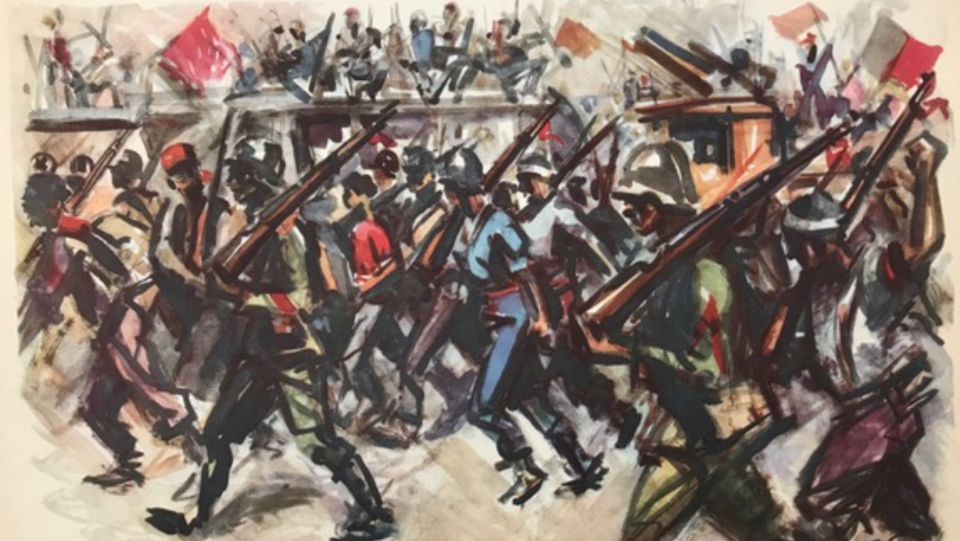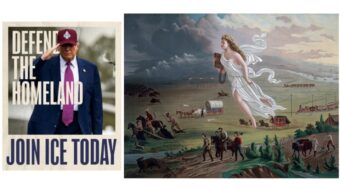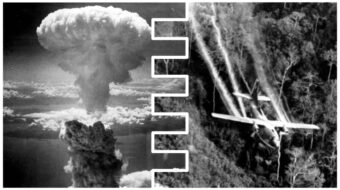
As Eulalia’s House has just come off the press, I want to introduce it to English-language readers with some personal reflections as its translator.
A parent, asked which of their children is the favorite, will spread out the fingers of one hand and say, “My children are like my fingers. Don’t ask me to name a favorite. They’re all precious to me.”
Eulalia’s House is the sixth of the eight books in the Manuel Tiago series (Manuel Tiago, as readers may recall, is the pen name for Álvaro Cunhal, longtime leader of the Portuguese Communist Party who wrote fiction in his spare time). All of these books have their unique merits. And yet I am going to break ranks with that parent and say that Eulalia’s House is at least one of my favorites. For four reasons:
The Spanish Civil War
Eulalia’s House is set in the early months of the Spanish Civil War (1936-1939). That crisis was the defining social issue of its time. With fascist régimes already established in Germany, Italy and Portugal, alongside militarist authoritarian states such as Japan, many millions around the world perceived the fascist danger in Spain and responded to the call. They knew that a fascist Spain, supported by the other fascist nations, would pose a threat to Western democracy in the rest of Europe. Such an axis of forces could only be a threat as well to the young socialist Soviet Union. A fascist victory in Spain would embolden the world’s anti-democratic reactionary entente among Junkers, capitalists, colonial imperialists, feudal latifundists and the Church.
Once the war broke out, volunteers streamed in from many lands, representing various political tendencies—Communist, Trotskyist, Socialist, anarchist, syndicalist, Republican—reflecting the different strands of domestic politics within Spain itself. From the United States at least a couple of thousand passionate young men and women joined with those from other lands in the reverently remembered International Brigades. The American contingent was called the Abraham Lincoln Battalion, often called a Brigade. To this day the Abraham Lincoln Brigade Archives (ALBA) continues to educate the world about these heroes, who risked and gave their lives in the defense of democracy. Their well-researched periodical The Volunteer is replete with their stories. When, following World War II, the volunteers came under investigation for their pro-democratic views by such bodies as the House Committee on Un-American Activities, they were dubbed “premature anti-fascists” for recognizing the threat that would soon engulf the whole world.
So the setting of this novel is a big factor. It’s highly ironic to think that somehow “antifa”—anti-fascists—are now considered contemptible in conservative and right-wing circles. Millions of Americans, not to mention many more worldwide, were fearlessly, fiercely committed to the “antifa” cause in the 1940s and won, my own father, in the Battle of the Bulge, among them. If you’re “anti-antifa,” that makes you pretty much a “fa” in my view!
Spain captured the imagination of artists in every medium around the globe. Well-known novels by Ernest Hemingway, Alvah Bessie and other Americans captured the sights and smells and passions of war, while British writer George Orwell’s Homage to Catalonia documented how the defenders of democracy actually went about building the new society within the shell of the old—and under shellfire from the unrelenting fascists. Documentary films such as The Spanish Earth powerfully brought the struggle of the Popular Front to viewers.
In other countries, too, artists tried to sound the alarm against fascism. The bold graphic arts of the period attest to widespread appeals for funding for ambulances, arms, refugee relief and other war-related causes. Spanish artist Pablo Picasso’s mural-painting Guernica may be the single most identifiable artistic response to fascist terror, and is certainly one of the signature art works of the 20th century. Scholar Paul Preston estimates that books about various aspects of the Spanish Civil War “number somewhere in the region of thirty thousand.”

In all of this artistic and historical output, mention is scarcely found of the response to the Spanish Civil War from neighboring Portugal. This is strange since Portugal had already been suffering under António Salazar’s fascist regime for a decade and was all too familiar with what lay ahead for the Spanish people—and the world—should the forces of Generalísimo Francisco Franco win. It was the author’s hope, and now mine with the release of this novel in English, that Eulalia’s House will help to fill some of that gap.
Fictionalized autobiography
In the early 1930s Álvaro Cunhal (1913-2005) was an up-and-coming leader of the Portuguese Communist Party, as of 1935 the secretary general of the Federation of Portuguese Communist Youth. In July of the following year, when he was almost 23 years old, he was sent to Spain on a special mission, to free from a prison in Cáceres two Portuguese comrades, Manuel Guedes and Pires Jorge. He would also assist in getting comrade Francisco Paula de Oliveira home from Moscow.
In Cunhal’s own words (my translation from a speech of his published in 1996), “A few days after I arrived in Spain, Franco unleashed the fascist coup, and the border with Portugal was occupied by the fascists a few days after that. Meanwhile, I had occasion to contact the Communist International, and transmit to them the Party’s decision that Francisco Paula de Oliveira return to Portugal. With the border under fascist control, I went to France via Catalonia; Francisco Paula de Oliveira joined me in Paris and together we planned our clandestine maritime voyage, arriving in Lisbon at the beginning of 1937.”
In Eulália’s House, the reader will immediately be struck how closely the protagonist António conforms to the author’s own experience. Unquestionably, he was wrestling in his later years with the memory of events he had lived through personally, trying to consolidate their lasting meaning in fictionalized form. It’s clear why he chose to write under a pseudonym, as a great deal of autobiographical data seeps into his fiction, as in other works. At the same time, the fictional format allowed him to incorporate incidents and representative persons he either knew himself or whose histories he had learned, and to relive, or reinvent, at least fictionally, parts of his own life. People today speak of multiverses, the whole course of events that would have unspooled had you made this decision rather than that one, and it seems Tiago is doing that here.
Rounded characters
Of all the books in the series so far, this is the first true novel. The Six-Pointed Star, about life in a fascist prison, is in my opinion also among his best books, but it’s a loosely connected series of collective pen-portraits of the men found in high-security detention—their character, their backstories, their behaviors and interactions. Some might not even call it a novel: There isn’t a plot as such, nor any denouement.
So my third reason for elevating Eulalia so high on my list is that Tiago is at his best form as a writer here developing his characters out of their specific actions, putting them through their paces as they evolve into people few could have imagined they’d become. As indeed so many Spaniards evolved under the most horrific of circumstances. One notable feature in this book is his portrayal of several women, both on the military front and on the home front, in many cases fully as brave and heroic as the men beside them. The liberation of women from traditional patriarchy was, after all, a major goal of the Popular Front against fascism. Aside from the leading characters, Tiago also places the reader amongst the Spanish masses, uprooted, suffering, oppressed and terrorized by war. Their collective portrait is as poignant as anything that happens to the principal figures in the novel.
As a writer Tiago is partial to the esthetic of Socialist Realism. Some of his writing is frankly meant to be illustrative and didactic. Rarely does he place before the reader characters with deep inner conflicts who confront their insecurities and fears: There is more of that in the magnum opus that will be the last translation to appear, Until Tomorrow, Comrades. But a reader finds here, especially in the lead character so like the author himself, genuine struggle with what it means to be a hero, what it means to face death, what it means to be a man. And in the character of Eulalia herself, who is perhaps somewhat less self-questioning, her issues are similar.
Readers will constantly be challenged to ask of themselves what they might do under such circumstances. At the same time, there is a profound gusto for life that often arises in people whose very lives are so precarious, and an irrepressible bent toward finding the funny and ironic in almost every situation. While this novel is written from a Communist point of view, there are moments when António questions if his party has every correct answer to every difficult situation.
Four: the illustrations
The illustrations we are including in Eulalia’s House come from a spiral-bound portfolio of Estampas de la Revolución Española 19 Julio de 1936 (Prints of the Spanish Revolution, July 19, 1936). They are chosen from the 30 full-color watercolor paintings included in the publication. The artist signs his name Sim XXXVI but is otherwise unidentified except in the brief introduction as “a son of the people.” It has since been established that the artist was José Luis Rey Vila (1900-1983), who left Spain in 1937, settled in Paris and apparently never returned to his homeland. He used a pseudonym to protect his family.

This portfolio was published in 1936 to raise funds for the Confederación Nacional del Trabajo (CNT) and the Federación Anarquista Ibérica (FAI), the National Federation of Workers and the Iberian Anarchist Federation. The very fact that the album speaks of the “Spanish Revolution,” instead of what may be more familiar formulations such as the “Spanish Civil War,” “defense of democracy,” “defending the Spanish Republic” or “stopping fascism,” may already have alerted the reader that politically speaking these illustrations come from a distinct sectarian orientation.
I remember so clearly the day and place I purchased this volume, which has remained in my possession ever since. It was at the Communist Party building on West 23rd St. in New York City, where I was living in the 1980s. The building used to have a library, and a bookstore on the street level, and from time to time they held sales of used books they had no space for or desire to retain in their collection. No doubt for reasons of political difference, this book was on the sale table, in close to mint condition. I recall that I paid $2 for it.
“When art becomes the interpreter of some great national sentiment, it is sublime,” the introduction reads. “It is as though some great singer of the sagas were relating the heroic deeds of his people, a mingling of the flesh with the spirit. And this is what is represented here. This album is the artistic essence of a great and pure movement of the masses. A movement towards emancipation of a kind that is worthy of the race, in which heroism is unfolded, and here [is] displayed the generosity of those ideals with which a people [is] moved.”
And that is the spirit in which we chose to recall to the world these mostly forgotten artistic expressions of the Spanish Civil War, which so powerfully capture the energy and movement, the elation and the despair that Manuel Tiago describes in his novel. The reader will see that when spontaneous militia formations emerged, little attention was paid to political orientation. Communists, Republicans, socialists, trade unionists, syndicalists and anarchists all fought side by side in the historic battles of the early months of the war. It was a true popular front of the people, though the fissures in it were certainly apparent.

Not to say that Tiago is oblivious to these divergent strands. At more than one point in this novel he is explicitly critical of the anarchists, though he also admires their courage, heroism and positive contributions. And who can say that any party in those most trying times acted nobly and correctly 100% of the time? Historians still question and debate the fact that though the Soviet Union was among the very few nations in the world that sent substantive assistance to the Republican side, it ended its support in 1938, before the war had ended, and with that, the famous International Brigades that came to Spain from many lands were sent home.
I’m saying all this in the hope that no reader or critic claims the publisher is “appropriating” these images as its own. To the contrary. Their source is clearly and honorably identified. These paintings from almost 80 years ago are reprinted in the book (alas only in black and white) in solidarity as a vote for more and greater unity of action in defeating the fascists of our own day. But here, online, we are able to share the original color versions of these powerful images. I might suggest that if you have a color printer, you can print these out to insert as your own addendum to the published book.
Manuel Tiago (Álvaro Cunhal)
Eulalia’s House
Translated from Portuguese by Eric A. Gordon
New York: International Publishers, 2022
152 pp., $15.99
ISBN: 9780717808786
Order your copy from International Publishers.










